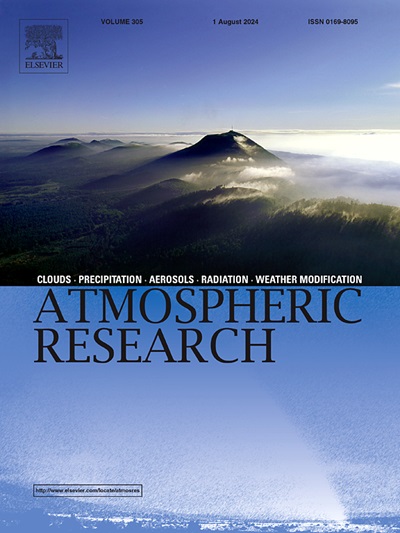The role of diabatic heating/cooling in outer rainbands in the secondary eyewall formation and evolution in a numerically simulated tropical cyclone
IF 4.5
2区 地球科学
Q1 METEOROLOGY & ATMOSPHERIC SCIENCES
引用次数: 0
Abstract
In this study, the role of diabatic heating/cooling in outer rainbands (ORBs) in the formation and evolution of the secondary eyewall of a numerically simulated tropical cyclone (TC) is investigated. This is done through a series of sensitivity experiments under idealized conditions using a high-resolution cloud-resolving atmospheric model. The results show that artificially increasing diabatic heating in rainbands enhances convective activities in ORBs and leads to an earlier secondary eyewall formation (SEF), and later the faster weakening and earlier dissipation of the primary eyewall. Reducing diabatic heating in ORBs weakens the rainbands and delays the SEF but prolongs the duration of the double eyewall structure if the SEF occurs. Reducing diabatic cooling in ORBs enhances convective activity in rainbands but has little effect on convection in the primary eyewall prior to the SEF. However, it results in a widened eyewall structure and a stronger TC after the eyewall replacement. Increasing diabatic cooling in ORBs largely suppresses convection in rainbands and prohibits the SEF. These results demonstrate that diabatic heating/cooling in ORBs plays important roles in the SEF and evolution. Since diabatic heating/cooling in rainbands is sensitive to the near-core environmental relative humidity, our results demonstrate the critical importance of large-scale environmental moist condition to the formation and evolution of secondary eyewall in TCs. In addition, it is also found that when the area-averaged diabatic heating rate in ORBs becomes similar in magnitude to that in the primary eyewall, the secondary eyewall forms.
Plain language summary
Previous studies have demonstrated the importance of diabatic heating/cooling in outer rainbands to the structure and intensity changes of tropical cyclones (TCs) with a single eyewall. It is unclear whether and how diabatic heating/cooling in outer rainbands may affect the formation and evolution of the secondary eyewall in TCs. These issues have been addressed based on a series of sensitivity experiments under idealized conditions using a high-resolution atmospheric model. Results show that diabatic heating in outer rainbands is favorable for the secondary eyewall formation (SEF). Increasing diabatic heating in outer eyewall can lead to faster weakening and thus earlier dissipation of the primary eyewall. Diabatic cooling in outer rainbands suppresses convection in outer rainbands and prohibits the SEF. Since diabatic heating/cooling in outer rainbands is sensitive to the near-core environmental relative humidity, our results demonstrate the importance of the large-scale environmental moist condition to the SEF of TCs. We also found that when the area-averaged diabatic heating rate in outer rainbands becomes similar in magnitude to that in the primary eyewall, the secondary eyewall would form, which can be considered as a measure of the SEF in TCs.
Key points
- 1.Increasing diabatic heating in outer rainbands leads to earlier SEF, and faster weakening and earlier dissipation of the primary eyewall.
- 2.Increasing diabatic cooling in outer rainbands suppresses convective activity in outer rainbands and is unfavorable for the SEF.
- 3.When the area-averaged diabatic heating rate in outer rainbands and the eyewall become similar in magnitude, the secondary eyewall forms.
数值模拟热带气旋中外层雨带的绝热加热/冷却对次级眼墙形成和演变的作用
在本研究中,研究了外雨带(ORB)中的绝热加热/冷却在数值模拟的热带气旋(TC)次生眼球的形成和演变中的作用。这是通过使用高分辨率云解析大气模型在理想化条件下进行的一系列敏感性实验完成的。结果表明,人为增加雨带中的二重加热会增强 ORB 中的对流活动,并导致更早的二次眼墙形成(SEF),以及更快的主眼墙减弱和更早的消散。减少 ORB 中的二重加热会减弱雨带,推迟 SEF 的形成,但如果出现 SEF,则会延长双层眼墙结构的持续时间。减少 ORB 的二重冷却会增强雨带中的对流活动,但对 SEF 前主眼墙中的对流影响不大。然而,它会导致眼墙结构扩大,并在眼墙替换后形成更强的热气旋。增加ORB中的二重冷却在很大程度上抑制了雨带中的对流,并阻止了SEF。这些结果表明,ORB中的二重加热/冷却在SEF和演变过程中发挥了重要作用。由于雨带中的二重加热/冷却对近核心环境相对湿度很敏感,我们的结果证明了大尺度环境湿度条件对TC中二次眼球的形成和演变至关重要。此外,我们还发现,当外雨带的区域平均二重加热速率与主眼球的二重加热速率大小相似时,就会形成副眼球。目前还不清楚外雨带中的二重加热/冷却是否以及如何影响热带气旋中二次眼墙的形成和演变。我们利用高分辨率大气模型,在理想化条件下进行了一系列敏感性实验,从而解决了这些问题。结果表明,外雨带的二重加热有利于二次眼墙的形成(SEF)。增加外雨带的二重加热会导致主雨带更快减弱,从而更早消散。外雨带的二重冷却会抑制外雨带的对流,从而阻碍 SEF 的形成。由于外雨带的二重加热/冷却对近核心环境相对湿度很敏感,我们的结果证明了大尺度环境湿度条件对TC的SEF的重要性。我们还发现,当外雨带的区域平均二重加热率与主眼球的二重加热率大小相近时,副眼球就会形成,这可被视为 TC 中 SEF 的一个衡量指标。3.当外雨带的区域平均二重加热率与眼墙的二重加热率大小相近时,就会形成副眼墙。
本文章由计算机程序翻译,如有差异,请以英文原文为准。
求助全文
约1分钟内获得全文
求助全文
来源期刊

Atmospheric Research
地学-气象与大气科学
CiteScore
9.40
自引率
10.90%
发文量
460
审稿时长
47 days
期刊介绍:
The journal publishes scientific papers (research papers, review articles, letters and notes) dealing with the part of the atmosphere where meteorological events occur. Attention is given to all processes extending from the earth surface to the tropopause, but special emphasis continues to be devoted to the physics of clouds, mesoscale meteorology and air pollution, i.e. atmospheric aerosols; microphysical processes; cloud dynamics and thermodynamics; numerical simulation, climatology, climate change and weather modification.
 求助内容:
求助内容: 应助结果提醒方式:
应助结果提醒方式:


